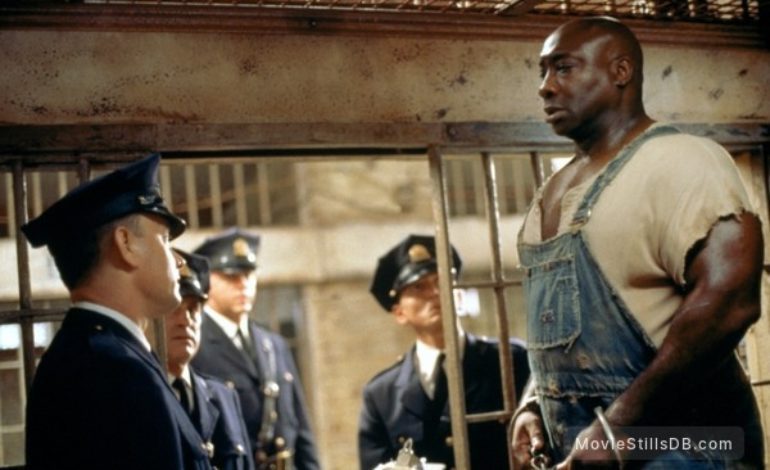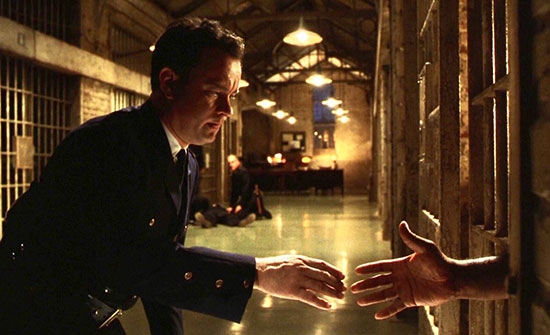Green Mile
The narrative of "The Green Mile" unfolds with a deliberate pace, allowing the audience to immerse themselves fully in the world of the Louisiana prison and its inhabitants. Darabont's meticulous attention to detail in both the script adaptation and the visual presentation ensures that every moment is imbued with significance, whether it be a subtle gesture or a profound revelation. One of the film's most compelling aspects is its exploration of the supernatural through the character of John Coffey. Possessing the ability to heal others, Coffey serves as a beacon of hope amidst the despair of death row. His mysterious powers challenge the conventional understanding of reality, prompting viewers to ponder the existence of forces beyond our comprehension. Through Coffey's interactions with the other characters, the film delves into themes of faith, miracles, and the interconnectedness of all living beings.
One of the film's most compelling aspects is its exploration of the supernatural through the character of John Coffey. Possessing the ability to heal others, Coffey serves as a beacon of hope amidst the despair of death row. His mysterious powers challenge the conventional understanding of reality, prompting viewers to ponder the existence of forces beyond our comprehension. Through Coffey's interactions with the other characters, the film delves into themes of faith, miracles, and the interconnectedness of all living beings. At its core, "The Green Mile" is a story about the transformative power of empathy and compassion. Paul Edgecomb's journey from a hardened prison guard to a compassionate advocate for justice mirrors the broader arc of the film's themes. His relationship with John Coffey becomes a catalyst for personal growth and moral awakening, forcing him to confront his own biases and preconceptions. In the process, Edgecomb discovers the redemptive potential of forgiveness and the importance of standing up for what is right, even in the face of overwhelming opposition.
At its core, "The Green Mile" is a story about the transformative power of empathy and compassion. Paul Edgecomb's journey from a hardened prison guard to a compassionate advocate for justice mirrors the broader arc of the film's themes. His relationship with John Coffey becomes a catalyst for personal growth and moral awakening, forcing him to confront his own biases and preconceptions. In the process, Edgecomb discovers the redemptive potential of forgiveness and the importance of standing up for what is right, even in the face of overwhelming opposition. The film's exploration of racism and prejudice adds another layer of complexity to its thematic tapestry. Set against the backdrop of the Jim Crow South, "The Green Mile" exposes the systemic injustices that pervade society, particularly in the criminal justice system. Characters like John Coffey and Eduard Delacroix are marginalized not only because of their crimes but also because of their race and social status. Their experiences serve as a stark reminder of the ongoing struggle for equality and justice in America.
The film's exploration of racism and prejudice adds another layer of complexity to its thematic tapestry. Set against the backdrop of the Jim Crow South, "The Green Mile" exposes the systemic injustices that pervade society, particularly in the criminal justice system. Characters like John Coffey and Eduard Delacroix are marginalized not only because of their crimes but also because of their race and social status. Their experiences serve as a stark reminder of the ongoing struggle for equality and justice in America. In addition to its thematic depth, "The Green Mile" boasts an ensemble cast that delivers exceptional performances across the board. Tom Hanks anchors the film with his portrayal of Paul Edgecomb, infusing the character with nuance and vulnerability. Michael Clarke Duncan's portrayal of John Coffey is equally remarkable, capturing the character's innate goodness and tragic fate with sensitivity and depth. The supporting cast, including David Morse, Barry Pepper, and James Cromwell, further enrich the film with their nuanced performances, bringing to life a diverse array of characters with their own struggles and aspirations.
In addition to its thematic depth, "The Green Mile" boasts an ensemble cast that delivers exceptional performances across the board. Tom Hanks anchors the film with his portrayal of Paul Edgecomb, infusing the character with nuance and vulnerability. Michael Clarke Duncan's portrayal of John Coffey is equally remarkable, capturing the character's innate goodness and tragic fate with sensitivity and depth. The supporting cast, including David Morse, Barry Pepper, and James Cromwell, further enrich the film with their nuanced performances, bringing to life a diverse array of characters with their own struggles and aspirations.
"The Green Mile" is also notable for its visual and auditory craftsmanship, which further enhances the emotional impact of the story. The film's cinematography, overseen by director of photography David Tattersall, skillfully captures the stark contrast between the bleak confines of the prison and the moments of transcendent beauty and grace. From the dimly lit corridors of death row to the lush greenery of the outdoor exercise yard, each frame is meticulously composed to evoke a specific mood or emotion. The film's use of lighting is particularly striking, with chiaroscuro techniques employed to create depth and atmosphere. Shadows loom large in the prison setting, symbolizing the moral ambiguity of the characters and the darkness that threatens to consume them. Conversely, moments of illumination, such as the healing scenes involving John Coffey, are bathed in a warm, ethereal glow, signifying the presence of divine grace and redemption.
The film's use of lighting is particularly striking, with chiaroscuro techniques employed to create depth and atmosphere. Shadows loom large in the prison setting, symbolizing the moral ambiguity of the characters and the darkness that threatens to consume them. Conversely, moments of illumination, such as the healing scenes involving John Coffey, are bathed in a warm, ethereal glow, signifying the presence of divine grace and redemption.
James Newton Howard's evocative score serves as the perfect accompaniment to the film's narrative, heightening the emotional resonance of key moments without overpowering the dialogue or visuals. Howard's compositions range from hauntingly melancholic to uplifting and triumphant, mirroring the ebb and flow of the characters' inner turmoil and eventual catharsis. The recurring motif of the film's main theme, with its haunting piano melody and swelling orchestral crescendos, serves as a leitmotif for the central themes of compassion, sacrifice, and transcendence.
In addition to its technical prowess, "The Green Mile" is distinguished by its thematic depth and universal resonance. Despite being set in a specific time and place, the film grapples with timeless questions about the nature of good and evil, the search for meaning and redemption, and the enduring power of human connection. By exploring these profound themes through the lens of a seemingly ordinary prison drama, the film invites viewers to reflect on their own beliefs and values, challenging them to confront the complexities of the human condition with empathy and humility. Ultimately, "The Green Mile" endures as a cinematic masterpiece not only for its technical excellence and compelling storytelling but also for its profound humanity and moral vision. Through its richly drawn characters, poignant themes, and masterful craftsmanship, the film transcends the boundaries of genre and medium, leaving an indelible impression on all who encounter it. As a testament to the enduring power of cinema to inspire, provoke, and uplift, "The Green Mile" stands as a timeless classic that continues to resonate with audiences around the world.
Ultimately, "The Green Mile" endures as a cinematic masterpiece not only for its technical excellence and compelling storytelling but also for its profound humanity and moral vision. Through its richly drawn characters, poignant themes, and masterful craftsmanship, the film transcends the boundaries of genre and medium, leaving an indelible impression on all who encounter it. As a testament to the enduring power of cinema to inspire, provoke, and uplift, "The Green Mile" stands as a timeless classic that continues to resonate with audiences around the world.



















































